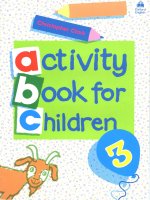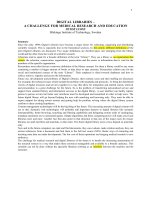Trauma Book for Medical
Bạn đang xem bản rút gọn của tài liệu. Xem và tải ngay bản đầy đủ của tài liệu tại đây (3.52 MB, 66 trang )
TRAUMA ANESTHESIA
Howard J. Miller, M.D.
GOALS
Introduction
Initial Evaluation
Preparation
Treatment
End Points of Resuscitation
Introduction
United States-Fourth leading cause of death.
Until age 44 yrs.-leading cause of death.
15-24 yrs.-77% of all deaths.
3.5-4.0 million years of potential life
lost/year
Greater than $100 billion in medical and
other expenses.
Introduction
Trauma: (Greek) an injury to living tissue caused
by an extrinsic agent.
Blunt (majority)
Penetrating
Thermal
Chemical
Ionizing radiation
Nuclear radiation
etc.
Introduction
Mortality
Trimodal Distribution
1st hour: 50% of all deaths secondary to CNS or
great vessel injury-not amendable to treatment.
1-4 hours: 30% of all deaths due to CNS or
hemorrhage-early intervention is of benefit.
1-6 weeks: 20% of all deaths due to multi-organ
failure and/or sepsis.
Initial Evaluation
ATLS-Advanced Trauma Life Support
American College of Surgeons
Early systematic approach to the injured
patient.
Improves overall survival by reducing
incidence of missed injuries and under
resuscitation
Initial Evaluation
ATLS
Preparation
Triage
Primary Survey (ABC’s)
Resuscitation
Secondary Survey (“head to toe”)
Further resuscitation and evaluation
Definitive Care
Preparation
Care team
Attending Anesthesiologist
Anesthesia resident and/or CRNA
Surgeon
Anesthesia Technician
Operating room nurses
Pathology
The Care Team In Action
Preparation
Operating Room Set-Up
Optimal readiness
Cost effectiveness
Final room preparation
Swank Getting Ready For a Torn
Thoracic Aorta
Treatment
GOALS
Secure the airway
Ventilation and oxygenation
Maintenance of hemodynamics
Maintain organ perfusion
Euthermia
Coagulation
Achieve end point(s) of resuscitation
Treatment
Patient Preparation
Oxygen
Standard monitors
Intravenous access
Invasive monitoring
Treatment
Airway
If intubated, confirm proper endotracheal tube
placement.
Not intubated, secure the airway.
Rapid Sequence Induction (always a full stomach)
Modified Rapid Sequence Induction
Awake intubation
Cricothyroidotomy/tracheostomy
Other-Always suspect c-spine injury
Bad Looking Airway
Do the Right Thing
Treatment
Fluid Administration
NS versus LR (plasmalyte, etc.)
Colloid versus crystalloid
Hespan, Hextend, Albumin
Blood Products
Treatment
Fluid Administration
Pressure bags
Hotline
Level 1 System
Rapid Infusion System
Level 1 – The Work Horse
100’s of Units of Blood Products
and Crystalloid
Resuscitation
Shock (ATLS): Abnormality of the
circulatory system that results in inadequate
organ perfusion and oxygenation.
Resuscitation is complete when:
Tissue acidosis is eliminated
Aerobic metabolism is restored
Oxygen debt has been repaid
Resuscitation
Adequate resuscitation does NOT equal
“normal” vital signs, (i.e. compensated
shock).
Scalea (1994) and Abou-Khalil (1994): 8085% of trauma patients had evidence of
inadequate resuscitation despite normal
blood pressure, heart rate, and urine output.
Elevated lactate and/or decreased mixed venous
oxygen saturation.
Resuscitation
Supernormal O2 transport variables
Shoemaker: repay the oxygen debt.
CI > 4.5 L/min/m2
DIO2 > 600 mL/min/m2
VIO2 > 170 mL/min/m2
Achieved with fluid, colloid, blood products
and vasoactive drugs.
Resuscitation
Supernormal O2 transport variables
Shoemaker - many studies
1998: Trauma victims, critically-ill patients,
and patients undergoing major operative
procedures.
Protocol group had statistically reduced mortality,
complications, duration of hospitalization, ICU
duration, mechanical ventilation, and overall cost.









